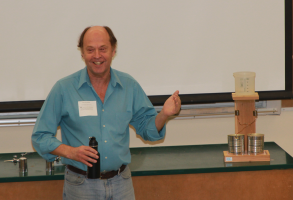Invited Talk: “Changes in the Teaching of Introductory Physics at Stanford” Chaya Nanavati or Stanford University
Chaya di scussed the existing structure that has an instructor that leads lectures and has Head TAs, Discussion TAs and Lab TAs that assist the smaller groups. Often we encounter several barriers to change: Administration or Colleagues are often resistant to change and need convincing, materials and time are necessary for change. She suggests using the already developed resources from Maryland University, Harvard, CU Boulder, etc. on group work and student-centered learning. Eric Mazur has lots of resources and evidence that interactive engagement increases the post-test gain on the Force Concept Inventory test. Continue reading “Spring 2013 Morning Invited Talks”
scussed the existing structure that has an instructor that leads lectures and has Head TAs, Discussion TAs and Lab TAs that assist the smaller groups. Often we encounter several barriers to change: Administration or Colleagues are often resistant to change and need convincing, materials and time are necessary for change. She suggests using the already developed resources from Maryland University, Harvard, CU Boulder, etc. on group work and student-centered learning. Eric Mazur has lots of resources and evidence that interactive engagement increases the post-test gain on the Force Concept Inventory test. Continue reading “Spring 2013 Morning Invited Talks”



